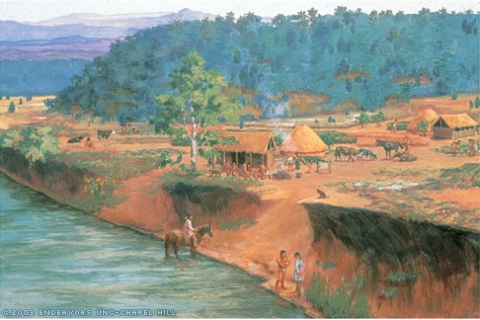Cherokee Heritage Trails Guidebook. By Barbara R. Duncan and Brett H. Riggs. University of North Carolina Press, 384 pages, $16.95.
In the early years the Cherokee people lived in little villages. And their only means of travel was trails.” So tells Jerry Wolfe, a Cherokee elder.
Have you ever wished you could go back to the time of trails, the time before roads, cars, and cities — before this land was the United States? What was it like to live here then? With the Cherokee Heritage Trails Guidebook, Barbara Duncan and Brett Riggs show you how to make just such a journey. “We invite visitors to learn from the landscapes of Cherokee history and experience — an experience no less American than their own,” says Riggs, Carolina research archeologist and adjunct assistant professor of anthropology. Riggs and Duncan, Education Director at the Museum of the Cherokee Indian, guide you to places and people of the earliest American history.
The Cherokee Heritage Trails, which in some places coincide with ancient Cherokee trails, are routes through the mountains of western North Carolina, eastern Tennessee, and northern Georgia. When you travel the Trails, you might find yourself hiking at Graveyard Fields off the Blue Ridge Parkway in North Carolina, where generations of Cherokees have picked blueberries and huckleberries. You might learn a traditional Cherokee dance or hear a storyteller at the Sequoyah Birthplace Museum’s Fall Festival in Vonore, Tennessee. Or you might end up in Knoxville, at the Frank H. McClung Museum, wandering through the artifacts and interactive exhibits depicting the history of native life in Tennessee.
Duncan, Riggs, and many Cherokee guides conduct you through these and myriad other sites from Cherokee, North Carolina, where about 8,000 members of the Eastern Band of Cherokee Indians live today on a remnant of their ancestral lands, to New Echota, Georgia, where a State Historical Site’s reconstructed buildings show how this former capital of the Cherokee Nation once looked. Cherokee and New Echota are two of the seven interpretative hubs that organize the Trails and the chapters of Cherokee Heritage Trails Guidebook. Each chapter contains maps, information about sites near the central location, side trips, scenic roads, outdoor areas, events, photographs, and drawings of Cherokee people, crafts, and natural places. An introduction, a timeline, and historical commentary throughout the chapters put places and people into context — and the direct voices of the Cherokee people, past and present, speak to you in many featured articles exploring topics from mound-building to folk tales to Indian Removal.
Each site currently on the Cherokee Heritage Trails was carefully chosen by the Cherokee people — through a task force with representatives from the Eastern Band of Cherokee Indians, the Museum of the Cherokee Indian, the North Carolina Arts Council, and the Tennessee Overhills Heritage Association — to represent their cultural heritage to visitors. Use the Cherokee Heritage Trails Guidebook to lead you to the Trails, where you can experience the living history of the Cherokee people. “Our history survived. Our culture survived,” writes Marie Junaluska, modern Cherokee storyteller and language specialist. “We’re still here.”
Michelle Coppedge was formerly a staff writer for Endeavors.




